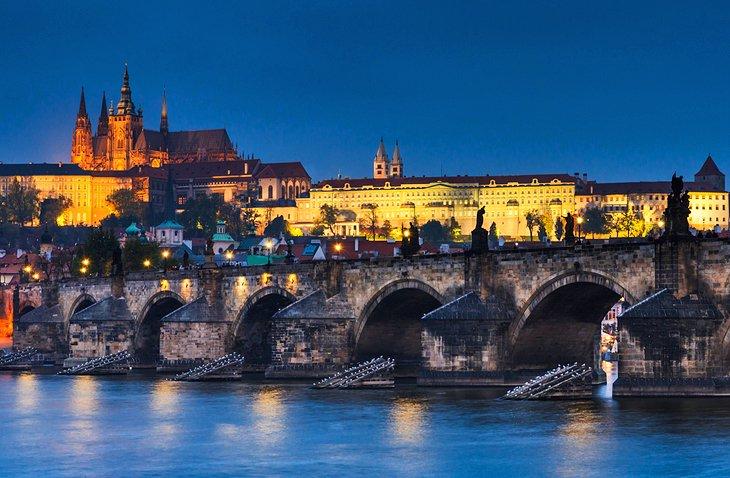The Czech Republic will not disillusion explorers searching for probably the best places to visit in focal Europe. Given its size - and gratitude to a top-notch public travel framework it's a simple nation to get around, especially for those anticipating investing the greater part of their energy investigating the country's delightful capital, Prague, which has almost perpetual touring openings and activities. However while Prague brags an unreasonable number of magnificent attractions, there are sufficiently far removed attractions to warrant investigating via vehicle. Features of an outing to the Czech field incorporate numerous phenomenal public parks and preservation regions. Perhaps the most famous is suitably named Bohemian Paradise, a region of exceptional common magnificence described by various awe-inspiring stone developments and numerous fine old palaces. Another zone worth visiting is Podyjí National Park in Moravia, the mainstream for its enormous, untainted woodlands. En route, you'll discover various old towns and towns, numerous unaltered since bygone eras, and home to fine old temples, royal residences, and public squares, every one of them worth a visit. For thoughts on the best places to visit, read our rundown of the top vacation spots in the Czech Republic. Grab the best deals and discounts in Czechia with Alaska airlines manage to book.
Prague Castle
For most explorers, the point of convergence of a visit to the Czech Republic is Prague Castle. It's on all Prague schedules. Situated in the city's Hradcany area and dating from the late tenth century, Prague Castle has been fundamental to Eastern European history for quite a long time, and has been home to Holy Roman Emperors, the Habsburgs, Bohemian rulers, and, all the more as of late, the Czech Republic's President. Throughout the span of its 1,000-year history, the château - the biggest on the planet as far as territory - has gone through numerous sensational changes in engineering style, proof of which can be found in the various structures built inside its dividers as the centuries progressed. Features of the manor incorporate wonderful St. Vitus Cathedral, St. George's Basilica, the Powder Tower, and the Golden Lane with its archaic workshops. English language-guided visits and sound aides are accessible.
Prague's Charles Bridge
It's difficult to visit Prague without setting aside the effort to navigate the city's most significant waterway crossing, the terrific Charles Bridge. This renowned design traversing the River Vltava was inherent 1357 and has numerous one-of-a-kind focal points along its 520-meter length, including various fine sculptures. Maybe the most acclaimed are those of the scaffold's namesake, Holy Roman Emperor Charles IV, just as the 1683 sculpture of John of Nepomuk, which respects the nation's most loved holy person who, incidentally, was purposely suffocated in the Vltava. The scaffold is very mainstream with travelers and photographic artists for its fine perspectives. Probably the best perspectives are really caught during off-top hours, at daybreak, and sunset, making for a considerably less jam-packed visit.
St. Vitus Cathedral
The church has a long history. Tracing all the way back to the year 925, when Prince Wenceslas constructed a church on the site, the structure developed alongside Prague's significance, and it before long turned into a basilica after the Prague parish was set up. There was another time of extension somewhere in the range of 1344 and 1419 when it started its change into a Gothic church, and the St. Wenceslas Chapel was fabricated. Development and fixes continued in the late eighteenth century, adding neo-Gothic components. Features of a visit incorporate seeing the bronze entryways decorated with reliefs of the church building's set of experiences, fancy stained glass windows in the sanctuaries, and the Royal Mausoleum. Sightseers ought to make certain to visit St. Wenceslas Chapel to appreciate the wall paintings, which are unique fourteenth-century portrayals of the stations of the cross, just as scenes portraying the existence of St. Wenceslas.
Also read about: Most Common Tips To Maintain Your Tyres
Prague's Old Town Square and Wenceslas Square
Prague's Old Town Square was the city's first market. Arranged at the convergence of shipping lanes, it actually has structures tracing all the way back to the tenth century. Notwithstanding its numerous archaic houses, the square is home to critical memorable milestones, including Old Town City Hall, which holds the Astronomical Clock, just as St. Nicholas Church. This square has been the site of many pivotal occasions in Czech history, including public executions and political fights. A sculpture of Protestant reformer Jan Hus remains in the middle, and this is a famous touring region that has Prague's conventional Christmas advertises every December. Simply a five-minute stroll from the Old Town Square sits Wenceslas Square in the core of the New Town. Not as new as it sounds, this huge public space was spread out in the fourteenth century as a pony market. Today, it is utilized for marches, celebrations, and on occasion, exhibitions. This is a mainstream traveler territory that is loaded up with lodgings, eateries, shopping, and diversion.
Cesky Krumlov Castle
Overwhelming the old town after which it's named, Cesky Krumlov Castle is surprisingly all around saved given its age. Dating from the thirteenth century, quite a bit of what stands today in this UNESCO World Heritage Site comes from the seventeenth century, including the Rosenberg Ballroom and the Renaissance Hall, the Royal Apartments, and the Chapel of St. George. Additionally worth seeing is the manor's old Baroque theater. Underlying 1682, it's actually utilized for unique exhibitions. Different features incorporate noteworthy assortments of works of art and woven artworks, alongside fine style and period furniture. The Ceský Krumlov Castle complex involves 40 structures, including fine old royal residences, mansion courts, and gardens. Vacationers could undoubtedly go through a few days meandering the grounds, albeit the individuals who need to see the features may appreciate one of the English language-guided visits that are accessible. You can visit Ceský Krumlov on a road trip from Prague. Contingent upon the strategy for transportation, you can arrive at the town in about 2.5 to three hours. If you get a promising beginning, this can be a charming trip.
















